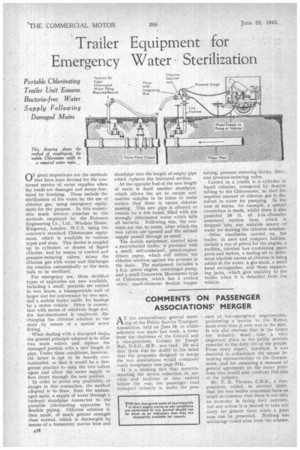Trailer Equipment for Emergency Water Sterilization
Page 20

If you've noticed an error in this article please click here to report it so we can fix it.
Portable Chlorinating Trailer Unit Ensures Bacteria-free. Water Supply Following
Damaged Mains
OF great importance are the methods that have been devised for the continued service of water supplies whenthe roads are damaged and mains,fractured by bombing. These include the sterilization of the water by the use of chlorine gas, using erhergency equipment for the purpose. In this connection much interest attaches to the methods emplayed by the Paterson Engineering Co., Ltd., Windsor House,Kingsway, London, W.C.2, using the concern's standard Chloronorne equipment, which is available in various type and sizes. This device is coupled up to cylinders or drums of liquid chloride, and by means of control and pressure-reducing valves, mixes the chlorine gas with Water and discharges the solution automatically to the main bulk to be sterilized.
For emergency use, three modified types of apparatus are now available, including a small, portable set carried in two boxes, a transportable unit of larger size for conveyance by two men, and a mobile trailer outfit, for haulage by a motor vehicle. Often in connection with mains of relatively large size, the last-mentioned is employed, discharging the chlorine solution to the main by means of a special screw fitting. • When dealing with a fractared mama the general principle adopted is to close two main _valves and replace the damaged portion with a new length of pipe. Under these conditions, however, the .latter is apt to be heavily contaminated, so that it would be a dangerous practice to open the two valves again and allow the water supply to flow direct through the new portion. In order to avoid any possibility of danger in this connection, the method adopted is to draw, from the undamaged main, a supply of water through a hydrant standpipe connected to the portable chlorinating apparatus by flexible piping. Chlorine solution is then made, of much greater strength than normal, which is discharged. by means of a temporary canvas hose and standpipe into the length of empty pipe which replaces the fractured section.
At the opposite 'hod of the new length of main is fixed another standpipe, which allows the air to escape and enables samples to be taken to make certain that there is excess chlorine passing. This new pipe is allowed ,to remain for a few hours, filled with the strongly chlorinated water which kills all bacteria. . Following this, the contents are run to waste, after which the two valves are opened and the n6rmal supply passed through as usual.
The mobile equipment, carried upon a two-wheeled trailer, is provided with a small, self-contained, petrol-enginedriven pump, which will deliver the chlorine solution against the pressure in the main. The equipment includes a h.p. petrol engine, centrifugal pump, and a small Concentric Manometer-type of Chloronome, which has a control valve, small-diameter flexible copper tubing, 'pressure metering device, filter, and pressure-reducing valve, Carried in a cradle is a cylinder of liquid chlorine, connacteci by flexible tubing to the Chloronome, so that the required amount of chlorine gas is dissolved in water for pumping. In the • case of mains, for example, a special connection is made, whilst there is also provided 20 ft. of 1-in.-cliimeter armoured suction hose, which is dropped 'into any suitable source of' water for snaking the chlorine solution.
Other anxiliacies carried on the trailer, in neat and compact fashion, include a can of petrol for the engine, a toolbox, another box containing spare parts and meters, a testing set to determine whether excess of chlorine is being added fo the water, a gas Mask, a small hand extinguisher, and three supporting jacks, which give stability to the trailer when it is detached from the vehicle.




















































